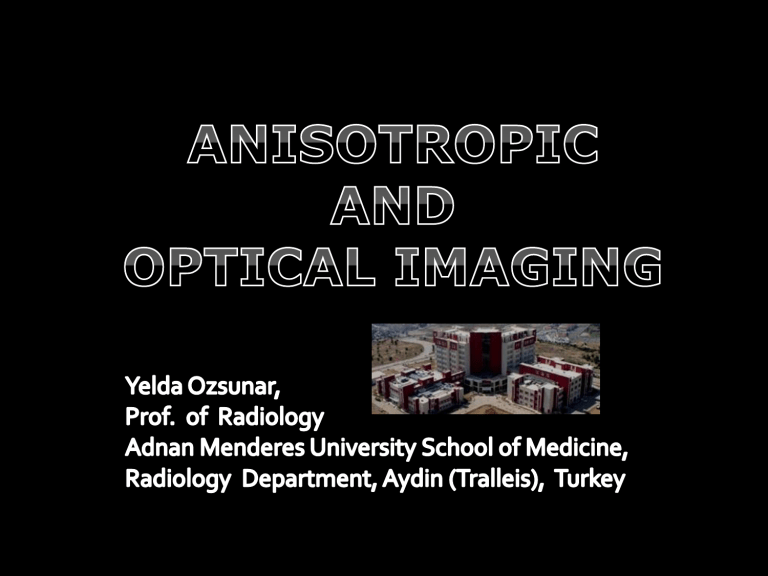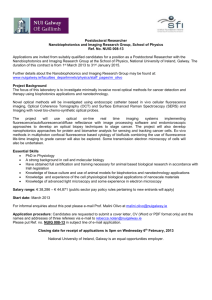Optik görüntüleme nas*l uygulan*r?

ANISOTROPIC AND OPTICAL IMAGING
New non-invasive brain imaging techniques
Both evolving from research era to clinical routine
Both are on scale of electromagnetic spectrum
Electromagnetic spectrum
-Wavelengths and energy have an inverse relationship
-The shorter the wavelengths, the higher the energy, the more harmfull effect for biological tissue
Flowchart
Anisotropic Imaging
Physical principals
Clinical Applications
Optical Imaging
Descriptions
Methods and Instrumentations
Clinical applications
Radiowaves:
Magnetic Resonance Imaging
Diffusion Weighted Imaging
Isotropic Imaging: DWI, ADC
Anisotropic Imaging: FA, DTI or Fiber tracking…
Isotropic Diffusion (CSF, etc)
H
+
H
+
Diffusion: Translational
Anisotropic Diffusion (myelin fiber, etc )
Directional
Isotropic Imaging
Choice of direction: not impotant
Applied gradients: at least 3
Anisotropic Imaging
Important at least 6 noncolinear direction
Eigenvectors:
3 principal axes of the diffusion tensor
Primary eigenvector: largest
The mean of 3 eigenvectors: ADC The variance of 3 eigenvectors: A.
Technique:
1,5-3 Tesla, gradient strength 20-60 mT/m, slew rate of 120 T/m/s,
TR/TE: 6000/100ms, FOV: 24cm, ax. or cor. plane with 3-5mm, b max:703-1000
(1,1,0) (1,-1,0) (0,1,1) (0,-1,1) (1,0,1) (-1,0,1)
ANISOTROPIC DATA
1) ANISOTROPY MAPS 2) TRACTOGRAPHY
FA: The most sensitive to lowest anisotropy
Volume Ratio: The most sensitive to highest anisotropy
Relative anisotropy: more linear
ANISOTROPY MAPS
R
Comissural fibers
L
2D Fibertracking
Projection fibers
Up
Can differentiate directions of WM
Post
Ant.
Down
Association fibers
DTI / Anisotropy
Unlike DWI alone, DTI can distinguish white matter from gray matter
2D or 3D anatomical imaging for fiber tracts
Deterministic methods (user defined
ROIs)
Probabilistic methods
Quantification
Measurements of A. in vivo and in formalin-fixed myelinated white matter show similar values
Clinical Applications
Ischemia
Tumor Imaging
Trauma
Demyelinating Diseases
Aging Brain
Psychiatric Diseases
Pediatric Neuroimaging
Post-treatment changes
A
DWI
A
B
FA
8 hours after onset
C
B
D
C
ADC
D
EP T2
DWI
FA
11 hours after onset
ADC
EP T2
FA v s T2 % Chang e
0.4
0.3
0.2
0.1
0
-0.2
-0.1
-0.1
0
T2 % Cha ng e
0.1
0.2
0.3
0.4
0.5
0.6
0.7
0.8
-0.2
-0.3
A significant negative correlation between FA and T2 signal change (r= -0.66, p=0.00025), (Ozsunar Y, AJNR,
2004)
Temporal evolution of anisotropy in ischemia
Pierpaoli C, Proc. Int. Soc. Magn. Reson. Med. 1996
T2
FA
Anisotropy
Increased anisotropic diffusion suggest continued structural integrity and tissue salvageability
Ozsunar Y, AJNR, 2004
A potential role for anisotropy in differentiating hyperacute stroke from acute or subacute stroke
Harris AJ Magn Reson Imaging 2004
Specific localization of pathways allow more accurate prognosis of long-term recovery or disability
Tumor imaging
Conventional MRI underestimates tumor extends
Help in preoperative planning
Benign tumors, metastases and meningiomas displace the neighbouring fiber tracts
Inflitrative glioma Low grade glioma
Tumor vs Peritumoral vasogenic edema
Vasogenic edema: reduced FA, but normal color hues
(Field AS, 2005,
Ann. N.Y. Acad. Sci.) DTI
Trauma : Diffuse axonal injury
Normal
CT and conventional MR imaging underestimate injury and correlate poorly with outcome
FA better corralete with clinic comparing ADC
Trauma
Huisman AGM, AJNR, 2004
young
Aging
FA of white matter declines and ADC values rise.
old
White Matter maturation
During infancy and childhood, anisotropy increases in developing white matter tracts.
Pediatric Neuroimaging
Decreased FA ( microstructural axonal damage, vasogenic edema)
Periventricular leukomalacia
Brain tumors
Multiple sclerosis
Idiopathic epilepsy unilateral congenital hemiparesis
Cortical dysplasia
Mukherjee P. Neuroimag Clin N Am
Hypoxic ischemic encephalopathy
Most methabolic d. (Krabbe,
Adrenoleukodystrophy … )
Pediatric Neuroimaging
Increased FA (dysorganisation, cytotoxic edema)
Heterotopia of gray matter
Partial agenesis of corpus callosum
Diffuse cerebral edema
Limitatons
DTI is oversimplification of the properties of water diffusion
DTI is more limited in areas of complex white matter architecture, such as branchs, intersections etc
Can not differentiate antegrade from retrograde along a fiber pathway
Resolution is limited
Artifacts: Eddy current, ghost, misregistration
Optical Imaging
What is Optical Imaging?
Light in physics refers to electromagnetic radiation of any wavelength, whether visible or not
energy high frequency harm for biological tissue
Wavelengths
Light versus Near Infrared
Harm for human
Wavelength (nm)
Frequency ( terra Hertz)
Penetration
Reflection
Scattering
Tissue absorbsion
Visible Light
Little
400-700
500-800
Good (1-3cm ?)
Little
More
Nonselective
Near Infrared Light (NIR)
Better
700-900 (1300)
300
Better
Better
Less
Selective (Hb, Mb, cyt. Ox)
What is Near Infrared?
Daily use of near infrared
TV's remote control.
visible light images
Infrared image
Biological tissues reflect more near infrared light compared to visible light http://www.nasa.gov/
Healthy plant Unhealthy plant http://www.nasa.gov/
Healthy brain Unhealty brain
How this works?
Medical use of Optical Imaging
First reported by Jöbsis in 1977
Pulse oxymetry
Optic nerve: Optical Coherance Tomography
Breast: Optical Mammography (Near Infrared Laser Light transmission )
Brain:
NIRS
functional imaging, not anatomical!
How tissue interacts with NIRS?
How tissue interacts with NIR?
Spectroscopy is interaction between radiation and matter
Near Infrared Spectroscopy
Diffuse Optical Imaging
Huppert et al Appl Opt. 2009.
What we get out of Optical Imaging
Noninvasively detect:
Oxy-haemoglobin (HbO)
Deoxy-haemoglobin (HHb)
Total hemoglobin (CBV )
Cytochrome oxidase (tissue oxygenation) associated with neural activity
Why NIRS are needed?
Bedside assessment of neonatal brain health
EEG, US, Transcranial Doppler
PET, SPECT: Radiation, expensive
NIRS
Similar information as functional Magnetic
Resonance Imaging (fMRI), but
near infrared spectroscopy (NIRS) vs fMRI,
Portable, smaller, bed site application
Higher temporal resolution
Spectroscopic information about both oxyhemoglobin and deoxyhemoglobin
Less expensive, safer
No need for immobility
Can not compete with spatial resolution MRI, US
Clinical utilities of NIRS
Tumor localization and characterization: breast
Monitoring tumor changes during neoadjuvant chemotherapy
Measurement of normal and abnormal tissue
physiological properties
Functional changes in the visual, auditory, and somatosensory cortices, motor, prefrontal cortices, cognitive and language systems
Seizures
Alzheimer’s disease
Neonate brain status
Stroke rehabilitation
Depression and schizophrenia
OPTICAL IMAGING
Optical Topography (2D) Optical Tomography (3D)
Near Infrared light
1-Continious Wave
2-Frequency Domain
3-Time Domain
Instrumentation
Optical Topography
-Real-time imaging modality
-Images can be displayed at a rate of a few hertz or faster
Optical tomography
Hebden JC, 2003
OxyHb Deoxy Hb
Passive movement of the right arm.
Optical Tomography (3D)
transverse slice imaging full three-dimensional imaging
Time domain optical tomography
Hebden et al.
1. Continuous Wave
Simple, inexpensive, portable
Useful for adult calvarium
Provide qualitative information
Measure the transmitted intensity with fixed spacing intensity time
Disadvantages CW
Quantification is impossible in human subjects
Limited depth information (We cannot obtain an image of brain function)
2. Frequency Domain
Most applicable for neonathal brain imaging
Measure intensity /phase shift of light signal
Quantitative measurement possible
Provide very fast temporal sampling (up to 50
Hz).
More complicated comparing CW,
Portable,
Easy to develop and use,
Inexpensive compared to TD
3. Time Domain
Measure delay of light pulse at detector
More complicated, more expensive
Acquire information at all frequencies simultaneously,
Provide depth information
Mostly are used for optical tomography
Austin T, NeuroImage 31 (2006) 1426 – 1433
32-channel time-resolved device known as MONSTIR (Multi-channel Opto-electronic Near-infrared
System for Time-resolved Image Reconstruction).
Limitations of NIRS
Incomplete knowledge of which region of the brain is sampled
Deep brain structure (diencephalon) can not be measured
Cross talk between oxyhemoglobin and deoxyhemoglobin concentrations
Artifacts (respiration, motion…)
Companies
Hitachi (ETG-100, ETG-7000)
Shimadzu
ISS (USA).
Philips
NIRx Medical Technologies (USA)
Hybrid instruments (CW+FD) are exist
Conclusion
Biomedical optics is one of the fastest growing areas of physics applied to medicine
Newborn infants are going to be one of the principal beneficiaries of optical technology
Thank you… yeldaozsunar@gmail.com







